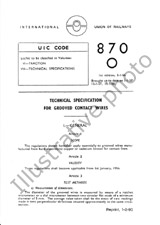We need your consent to use the individual data so that you can see information about your interests, among other things. Click "OK" to give your consent.

UIC B126/DT422-1ed.
Influence of head and tail wind on the braking distance of trains and single vehicles
Translate name
STANDARD published on 1.12.2011
The information about the standard:
Designation standards: UIC B126/DT422-1ed.
Publication date standards: 1.12.2011
SKU: NS-1190169
The number of pages: 36
Approximate weight : 108 g (0.24 lbs)
Country: International technical standard
Category: Technical standards UIC
Annotation of standard text UIC B126/DT422-1ed. :
Speed and direction of the wind influences the trains longitudinal running resistance (resistance to forward movement). Also the train stopping distance during a brake application is influenced by the presence of wind. A model to estimate the influence of wind speed on stopping distances for different types of rolling stock is presented in the case of pure head or tail wind condition. Due to the limited validity of the model used, the behaviour of different types of rolling stock is compared under these two sets of wind conditions only (yaw angle equal to 0° and 180°), although ERRI wind tunnel tests (see ERRI report A168 RP3) demonstrate that drag is not at maximum under these wind conditions and these conditions therefore do not represent the worst-case scenario. "+ "
Name:Einfluss von Gegen- und Rückenwind auf den Bremsweg| Geschwindigkeit und Richtung des Windes beeinflussen den Laufwiderstand eines Zuges in Längsrichtung. Auch der Bremsweg eines Zuges während des Bremsvorganges wird durch Wind beeinflusst. Ein Modell zur Einschätzung der Auswirkung der Windgeschwindigkeit auf Bremswege verschiedener Fahrzeugbauarten unter reinen Gegen- und Rückenwindbedingungen wird vorgestellt. Aufgrund der beschränkten Gültigkeit des verwendeten Modells wird das Verhalten von verschiedenen Fahrzeugbauarten nur unter diesen beiden Windbedingungen verglichen (Scherwinkel gleich 0° und 180°), obwohl Versuche des ERRI im Windkanal (siehe ERRI-Bericht A168 RP3) zeigen, dass der Luftwiderstand unter diesen Windbedingungen nicht den höchsten Wert erreicht und diese Bedingungen daher nicht den ungünstigsten anzunehmenden Fall darstellen. "+ "
We recommend:
Technical standards updating
Do you want to make sure you use only the valid technical standards?
We can offer you a solution which will provide you a monthly overview concerning the updating of standards which you use.
Would you like to know more? Look at this page.



 Cookies
Cookies
